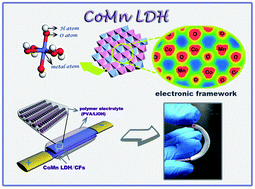CoMn-layered double hydroxide (LDH) nanowalls were supported on flexible carbon fibers (CFs) via an in situ growth approach; the resulting CoMn-LDH/CF electrode delivers a high specific capacitance (1079 F g−1 at 2.1 A g−1 normalized to the weight of the active LDH material) with excellent rate capability even at high current densities (82.5% capacitance retention at 42.0 A g−1). A combined experimental and theoretical study reveals that the dramatic performance enhancement is mainly attributed to the homogeneous and ordered dispersion of metal units within the LDH framework, which enriches the redox reactions associated with charge storage by both Co and Mn. The hierarchical configuration further improves the exposure of active sites and enables a fast charge transfer to the electrode/electrolyte interface, with CFs serving as both the current collector and binderless electrode. In addition, a solid-state supercapacitor device with good flexibility was fabricated using the CoMn-LDH/CFs, which achieves a specific energy up to 126.1 W h kg−1 and a specific power of 65.6 kW kg−1. By virtue of rational design of the chemical composition and architecture, this work demonstrates a facile strategy for the fabrication of a hierarchical configuration based on CoMn-LDH nanowalls anchored to CFs, which can be potentially used in wearable and miniaturized devices for energy storage.

You have access to this article
 Please wait while we load your content...
Something went wrong. Try again?
Please wait while we load your content...
Something went wrong. Try again?


 Please wait while we load your content...
Please wait while we load your content...